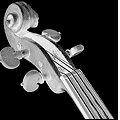
|
|||||||||
 |
Of
Note Conservatory Dedicates Hannan Hamburg Steinway The Conservatory received a significant and stunning addition to its collection of 1,700 period and modern musical instruments last July: the Hannan Hamburg Steinway, a gift from the family of William J. Hannan Jr. '64, who died in September 2001. Hannan's parents, W. Jay and Yrsa E. Hannan, say their gift commemorates the love that Bill had for Oberlin throughout his life. For many years, Bill served as alumni class president and spent much time fund raising; his letters soliciting donations from his fellow alumni were known for their wit and charm. He was also an active member of the Alumni Council. Bill remained elated with news of Oberlin - the accomplishments of its graduates and the performances from its Conservatory - throughout his life, and he cherished the friends he made here. Conservatory faculty members Angela Cheng, Alvin Chow, Monique Duphil, Lydia Frumkin, Sedmara Rutstein, Robert Shannon, Haewon Song, and Peter Takács performed works by Brahms, Debussy, Chopin, Ravel, Bach, Liszt, and Beethoven, respectively. The
Hannan Hamburg Steinway is a Model "D" Hamburg. Nearly nine feet
long and weighing nearly 1,000 pounds, it is encased in ebonized
walnut and birch with solid brass hardware. More information on
the Hamburg Steinway's specifications can be found at steinway.com.
Steinway & Sons celebrates its 150th anniversary in 2003.
Conductor Steven Smith Joins Faculty
Steven Smith, who is also Music Director of the Cleveland Orchestra Youth Orchestra, is Music Director of the Santa Fe Symphony. Last summer he conducted the Aspen Concert Orchestra at the Aspen Music Festival as well as two Cleveland Orchestra concerts at Blossom Music Center. "Steven's experience with professional musicians, as well as with emerging musicians, has prepared him wonderfully for leading the Conservatory's orchestral program, and we are delighted to welcome him," says Dodson. Smith has held previous positions with the Kansas City Symphony (KSO), the San Juan Symphony, the Colorado Springs Symphony, and Epicycle: An Ensemble for New Music, and he is also in frequent demand as a guest conductor. During his tenure with the KSO, he was the sole recipient of the Conductor Career Development Grant and was named Foundation Artist by the Geraldine C. and Emory M. Ford Foundation. Smith is also a composer. In 1991, the Cleveland Orchestra commissioned and performed the world premiere of his Shake, Rattle & Roar, an interactive piece for orchestra and audience. The work was featured on National Public Radio and has since been performed by the Los Angeles Philharmonic, the National and Columbus symphonies, and other ensembles. Smith
earned master's degrees from the Eastman School of Music and the
Cleveland Institute of Music.  Oberlin
Celebrates a Century of Music Education Oberlin
Celebrates a Century of Music Education
"Music for every child, every child for music." Most music teachers are familiar with this sentiment, made famous in the early 1920s by Karl Wilson Gehrkens, a 1905 Oberlin College graduate and president of the Music Supervisors' National Conference (known today as MENC, the National Association for Music Education). Building from the first course in music education taught at the Conservatory - in 1902 - Gehrkens established at Oberlin, in 1921, the first four-year, college-degree program in music education in the United States. The Conservatory celebrated its century of music education November 9, 2002, with a daylong series of lectures and workshops sponsored by the music education department and featuring alumni. Among those who returned to campus were Carolyn Foulkes '75, Music Coordinator at the Baltimore School of the Arts; Sharon Davis Gratto '66, Director of Music Education at Gettysburg University; Jonathan Handman '96, Director of Stringendo, a community string program in Poughkeepsie, New York; and Penelope Cruz '91, Music Department Coordinator at the Poly-Tech Prep Country Day School in Brooklyn. In
other music education news, Associate Professor and Director of
Music Education Joanne Erwin, Associate Pro-fessor of Music Education
Jody Kerchner, and Professor of Music Education John Knight, along
with former music education faculty member Kay Edwards, have Erwin
and Professor of Music Education Peggy Bennett wrote an article
titled "Karl Gehrkens: Ohio Son, Music Education Pioneer, Comprehensive
Musician" for TRIAD, a publication of the Ohio Music Educators Association.
Lofty Pursuits: Organ Inspires Symposium, Hymn Festival, and Radio Shows Cavaillé-Coll in Oberlin, an inter-national symposium on French Romantic organ music held on campus last June, convened leading organists, organ builders, and scholars for recitals, lectures, demonstrations, and panel discussions. The four-day event featured a series of concerts on the Kay Africa Memorial Organ by Oberlin professors David Boe and Haskell Thomson. Jean Boyer, Martin Jean, Hans-Ola Ericsson, Susan Ferré, and Christa Rakich '74 also performed. John
Near, Paul Peeters, and William Peterson '70 presented papers on
Cavaillé-Coll, his place in history, and his influence on
contemporary organ building and performance. These lectures were
the basis for panel discussions that included Thomson, Steven Dieck
(President of C.B. Fisk, Inc., builders of the Africa organ), Fenner
Douglass '42, William Porter '68, and Rakich. The event also featured the Oberlin College Choir and Oberlin Musical Union, prepared by Assistant Profes-sor of Choral Conducting Hugh Floyd. More than 1,000 people attended, and all raised their voices in song. The Conservatory sponsored the event along with the Office of Chaplains and the Alumni Association. "We were honored that John Ferguson - whose name is almost synonymous with the words hymn festival - returned to his alma mater to conduct this event," says Protestant Chaplain Manfred Lassen. "He is a respected and expert teacher, performer, improviser, and leader of congregational song." The festival was recorded and edited for broadcast, and the program, hosted by WCLV radio's President Robert Conrad, aired in northeast Ohio on the station and on its web site on Thanksgiving Day. WCLV/Seaway Productions also syndicated the program for national broadcast on more than 115 radio stations. The
Africa organ also was featured on two other recent radio programs.
Last April, excerpts from the dedication concerts were showcased
on Pipedreams, the nationally distributed Minnesota Public Radio
program hosted by Michael Barone '68. And in July, orchestral and
solo performances from the dedication concerts were featured in
a two-part series on The Organ Loft, broadcast in the Pacific North-west
on radio station KING-FM and hosted by alumnus Roger Sherman.
The Lawrence McDonald Conservatory Scholarship Fund If Béla Schwartz and David Ballon have anything to say about it, Professor Lawrence McDonald's name will remain a part of the Conservatory for generations to come.
McDonald, who retired in 2000, was a professor of clarinet at the Con-servatory for 30 years. Upon learning about their former teacher's plans to leave Oberlin, Schwartz and Ballon, both '79, mailed letters to many alumni, asking them to contribute to a scholarship that would serve as a tribute to McDonald and a gift to future clarinet students. After months of hard work - and after Schwartz and Ballon had made several significant gifts of their own - the Lawrence McDonald Conservatory Scholarship Fund was officially en-dowed in July 2001, surpassing its goal of $25,000. Last year, the merit-based scholarship had its first recipient, Andrew McCollum '05, a clarinet and composition major from Winston-Salem, North Carolina. "We encourage any former student of Larry's to contribute to the fund," says Ballon, managing director of a London-based money management firm. "It's
a testimony to Larry," says Schwartz, a double-degree graduate who
is chief financial officer for a private equity firm. "As students,
we all became aware that Larry was not only teaching us to play
technically, but showing us how to make music." OCEAn New Music Festival Makes Waves in Oberlin and Cleveland Nearly 40 academic, freelance, and student composers converged on Oberlin and the Here Here Gallery (the College's downtown Cleveland performance and gallery space) last November to perform in a sonic extravaganza of contemporary electronic works. What brought them all together was the 2002 biennial festival of new music OCEAn (Ohio Com-munity of Electro-Acoustic n, where n is a variable). Several festival concerts were broadcast live on WOBC, the student-run college radio station, and simulcast on www.wobc.org. The festival received outside media attention when Assis-tant Professor of Computer Music and Digital Arts Tom Lopez '88 and Teacher of Wind Chamber Music and Flute Kathleen Chastain were interviewed in conjunction with the two-day event on WCPN, Cleveland's public radio station. "The
festival gave aficionados and newcomers to electronic music a chance
to see and hear a wide range of works that demonstrate the impact
of technology on music," says Lopez, the event's founder. New works
presented at the festival included video and dance collaborations,
music composed in real-time on a laptop computer, and interaction
between computers and traditional performers on flute, violin, saxophone,
percussion, and other instruments. Everything Old is New again
Wouldn't Smetana be pleased? - When the premiere curtain rose on Oberlin Opera Theater in May 1952, his beloved opera The Bartered Bride was the first production to be unveiled. Fifty years later, the Bohemian revelers were at it again as Oberlin marked a half century of bringing thwarted love, mistaken identities, and love regained to northeast Ohio opera fans - launching some impressive international careers along the way. Conservatory Hosts From The Top and Bobby McFerrin Hosted by pianist Christopher O'Riley, the program has been called "the best thing to happen to classical music since Leonard Bernstein's Young People's Concerts." Among the performers showcased on the Oberlin program were Oberlin Conservatory composition and music theory major John Levey '03, who conducted McFerrin and members of a wind nonet from the Cleveland Orches- tra Youth Orchestra, string players from the Juilliard School of Music's Pre-College, and a 16-year-old soprano from Appleton, Wisconsin. Coproducer
of From the Top is Scott Schillin '68. Sara Stackhouse '91 is the
show's guest artist coordinator and education director.
Live from Oberlin: Piano Competition Finals For the first time in its eight-year-history, the finals of Oberlin's Interna-tional Piano Competition were broadcast live to Cleveland-area listeners on WCLV and simulcast on wclv.com. The competition was held last July in Warner Concert Hall at the end of the annual week-long piano festival. Jung Lim Kim, a 17-year-old student at the Seoul Art High School in Korea, was the first-prize winner of the competition for pianists age 13 through 18. Second prize went to Jeannette Fang, 17, of Bridgewater, New Jersey, a student at Juilliard's Pre-College Division. Martin Leung, 15, of Irvine, California, won third prize. Further radio coverage ensued when The McGraw Hill Young Artists Showcase on WQXR, the classical radio station of The New York Times, featured finals performances by the prizewinners in a program that aired in November and also included excerpts from Oberlin's production of Le Pouvoir de l'Amour. Judges
for the finals round were Joseph Schwartz, Emeritus Professor of
Piano; Monique Duphil, Professor of Pianoforte; John Weems; Antonio
Pompa-Baldi; and Li MingQiang. Oberlin Professor of Pianoforte Robert
Shannon '71 is director of the competition and festival.
Legendary Brubeck Album Jazz at Oberlin Marks 50 Years The phrase "jazz at Oberlin" has been part of the Oberlin Conservatory of Music's official lexicon since 1972, when jazz studies was incorporated into the curriculum. It is shorthand reference to the Conservatory's renowned department and the many jazz concerts presented annually by its acclaimed faculty and outstanding young student musicians. But the phrase became known worldwide nearly two decades earlier, when, on March 2, 1953, the legendary Dave Brubeck Quartet recorded the landmark album Jazz at Oberlin live in Finney Chapel. Oberlin will celebrate this auspicious anniversary on Saturday, October 4, 2003, when it welcomes Brubeck and his quartet back to campus for a concert in Finney Chapel, the venue where it all began. After the concert, Oberlin will present Brubeck with an honorary doctor of music degree. "We are pleased to have played a part in the history of the Dave Brubeck Quartet, and we are proud to acknowledge its role in our own history," says Dean of the Conservatory Robert K. Dodson. Jazz at Oberlin was an extremely popular record for Brubeck's quartet and a smashing success in the Oberlin community. The concert and album presented an audience largely uneducated in jazz with some of the genre's finest players performing at the top of their game. And while a successful jazz concert at Oberlin these days is a regular occurrence, such was not the case in 1953, when the concert halls at Oberlin - like those at most conservatories of music - were filled with Bach, Beethoven, Brahms, and occasionally Bartôk, but not with Basie or Baker. "There
definitely was no jazz department in the Conservatory, and no interest
in having a jazz department at the time," recalls James Newman '55,
who was instrumental in bringing the Dave Brubeck Quartet to Oberlin
in 1953. Despite the climate on campus, the aspirations of Newman and a few forward-looking students gave way to what would become an important historical event. "It was very exciting, and as you can tell from the recording, the response was extraordinary," Newman says. The cheers from the crowd are well documented on the album. On all tracks the group swings effortlessly. Paul Desmond's airy alto sound floats, and Brubeck remains firmly locked in with bassist Ron Crotty and drummer Lloyd Davis. Jazz critic Gary Giddins has written that the album would "make many short lists of the decade's outstanding albums." Engineers
from WOBC, the College's radio station, recorded the concert, and
Brubeck's label, Fantasy, obtained the tapes and produced the album,
which is considered by many to have been a catalyst for an extraordinarily
successful and lasting career. "Nationally known jazz bands had come to Oberlin before, but mainly to play at dances. The trend of going to a jazz concert simply to listen was a novel idea, and the Brubeck concert was a major factor in starting that trend," he says. "I always considered Jazz at Oberlin a breakthrough album for the quartet," says Brubeck. "It caught Desmond and me in the early days when we were beginning the concept of 'jazz goes to college' as a concert performance." - Jonah Berman '03 Ed. Note: Brubeck's upcoming performance is part of the 125th anniversary season of Oberlin's Artist Recital Series. The Conser-vatory's web site, www.oberlin.edu/con, will post further concert information as it becomes available. [Back to Top] |
||||||||

 For
years Bill played a Steinway grand piano. He wanted his estate to
provide the means for Oberlin to receive a superb piano. He specified
that the instrument be a Hamburg Steinway, and his parents have
honored his wish. They and other members of the Hannan family were
the guests of honor at a concert dedicating the piano last October
in Warner Concert Hall.
For
years Bill played a Steinway grand piano. He wanted his estate to
provide the means for Oberlin to receive a superb piano. He specified
that the instrument be a Hamburg Steinway, and his parents have
honored his wish. They and other members of the Hannan family were
the guests of honor at a concert dedicating the piano last October
in Warner Concert Hall.
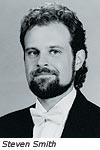
 Hymn
lovers convened on campus last September for Songs for the Journey,
a hymn festival that brought 50 church and community choirs from
throughout northern Ohio to Finney Chapel. The festival was conceived
and conducted by John Ferguson '63, organ professor and choral conductor
at St. Olaf College in Northfield, Minnesota.
Hymn
lovers convened on campus last September for Songs for the Journey,
a hymn festival that brought 50 church and community choirs from
throughout northern Ohio to Finney Chapel. The festival was conceived
and conducted by John Ferguson '63, organ professor and choral conductor
at St. Olaf College in Northfield, Minnesota.
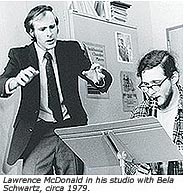
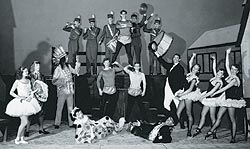
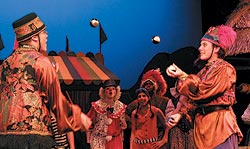
 Anyone
not among the more than 1,000 enthusiastic classical music lovers
who turned out for a taping of From the Top, with special guest
Bobby McFerrin, did not have to worry. The Public Radio International
program, recorded in Finney Chapel in January, aired in April on
nearly 250 radio stations throughout the United States.
Anyone
not among the more than 1,000 enthusiastic classical music lovers
who turned out for a taping of From the Top, with special guest
Bobby McFerrin, did not have to worry. The Public Radio International
program, recorded in Finney Chapel in January, aired in April on
nearly 250 radio stations throughout the United States.